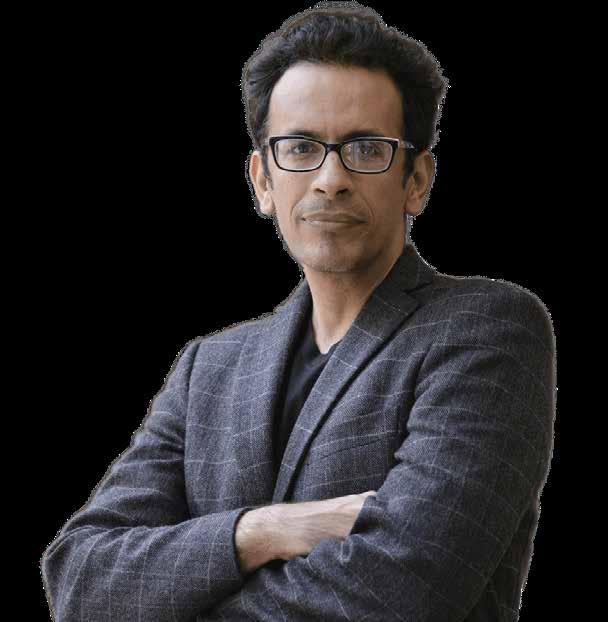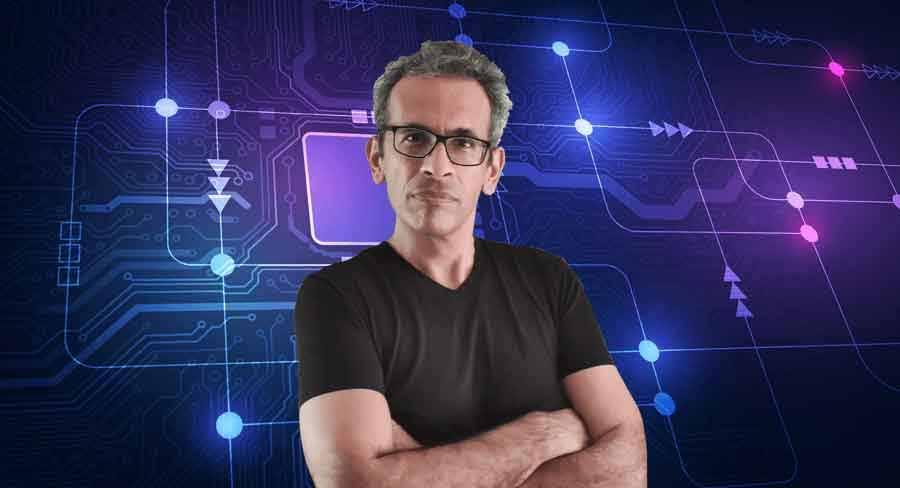
5 minute read
Rendezvous with Founder
Gabbar Interviewed the Chief Blockchain Architect of the Hybrid Finance Project,
Rohas Nagpal
Advertisement
Rohas Nagpal
For the month of January, CoinGabbar talked to the popular face of the Blockchain industry, Rohas Nagpal.
The Chief Blockchain Architect of the Hybrid Finance Project (HyFi) and author of the Crypto Playbook, Rohas Nagpal is a columnist for NDTV and Mint and conducts the free Web3 Developer Course. He also mentors early-stage Blockchain startups.
I started my career in the early 90s as a hacker. Those were the days of Solaris, FreeBSD, Windows NT & Novell NetWare. My lifelong love affair with Cryptography started when I chanced upon David Chaum's work on blind digital signatures and the "Handbook of Applied Cryptography" by Menezes, Oorschot & Vanstonemy.
In 1999, I co-founded the Asian School of Cyber Laws. Over the next 16 years, I worked in cyber investigation & cyber law. I proudly count some of the best investigators & lawyers among my students. I have also had the privilege of assisting the Govt. of India in framing draft rules under the Information Technology Act.
My work spanned 18 countries and I have investigated cyber crimes & data breaches for hundreds of organizations across many sectors - from aerospace & banking to law enforcement, pharma & shipping. I also had the privilege of leading the teams that developed "The Collaborative Online Investigation Network" & the "ASCL Volatile Evidence Retrieval Tool".
I authored the Cyber Crime Investigation Manual, which has been referred to as a "bible for cybercrime investigators" by the Times of India.
I authored the Cyber Crime Investigation Manual, which has been referred to as a "bible for cybercrime investigators" by the Times of India.

In 2016, I co-founded BankChain - a community of 37 banks plus IBM, Microsoft & Intel. Our core product was a "self-building" blockchain ecosystem with a web app, PWA, and a Blockchain REST API service. The project went into hibernation in early 2018 after the Reserve Bank of India's ban on crypto. I continued as a Blockchain Architect for some very interesting projects.

In 2020, after the Supreme Court struck down the RBI ban, I became actively involved with the crypto industry. Currently, I am the Chief Blockchain Architect of the Hybrid Finance Blockchain (HyFi).

Q.
Tell us about HyFi. What is HyFi and Why does the world need it?
HYFI Blockchain is a permissioned Layer-1 Blockchain with distributed consensus between identified block validators. It has full support for data privacy, KYC, AML, CFT & other regulatory compliances.
HYFI's core product is FLIPs. A fractional License of Intellectual Property (FLIP), is a type of digital asset that represents fractional ownership of a specific intellectual property, such as art, books, movies, music, software & video games.
FLIPs are a new asset class that allows for the fractionalization & tokenization of intellectual property rights on the HYFI Blockchain. This means that creators can now monetize their intellectual property rights in a more efficient, cost-effective, and transparent way.
With the use of FLIPs, creators can now sell a small percentage of their intellectual property rights to multiple investors, allowing them to raise capital while still retaining ownership of their work. This also enables investors to purchase a small stake in a piece of intellectual property, making it accessible to a wider range of people. Additionally, FLIPs can be traded on the HYFI Marketplace, allowing for a secondary market for these assets to exist. FLIPs can also be securely stored in the HYFI Wallet.
Q.
And how is HyFi helpful to a newbie?
HyFi can help budding artists, authors, filmmakers, musicians, and tech startups make more money.
Q.
When did you decide to dive into the blockchain space? How
did you
start?
I first heard of Bitcoin in 2011, when I was assisting the police in a case involving the drug mafia. I found the concept fascinating and even mined some bitcoins.
And then I made one of my biggest mistakes. I "deleted" my bitcoins!
In 2015, I decided to move into the blockchain space. I barricaded myself at home and spent 4 months studying bitcoin technology and setting up multichain blockchains. Since then it's been a
Q.
Is it true that you deleted your Bitcoins? How many did you delete and do you regret doing that?
Yes, it's true! But I don't want to think about it anymore :-)
Q.
Would you like to share the wisdom you gained while working as a cybercrime investigator & forensic expert?
Anything can be hacked!
You can have the best security systems in the world and you still can get hacked! That does not mean we give up on security. It means that we have to plan for the inevitable!
Q.
You’ve worked with multiple
Blockchain Projects
in the past, how HyFi is different and better than the rest of them?
All the projects I have worked on are awesome. But what I really like about HYFI is that we are using blockchain to the maximum for solving 3 massive global problems:
- Traditional methods for managing & monetizing intellectual property rights in the art, books, movies, music, software & video games industry are inefficient, costly, and lack transparency.
- Creators are not connected to the end-consumers. This results in limited engagement & monetization.
-Investors do not have access to high-growth Intellectual Property assets.
Q.
What do you think about the future of blockchains? Share
your long-term views
I believe that there is only one blockchain use case - Smart Asset Lifecycle Management. This includes issuance, transfer, exchange, escrow, reissuance, redemption, one-way payments, atomic transfers, multi-sig transactions, retirement, and destruction. A blockchain smart asset is the digital representation of a real-world asset (e.g. gold, equity shares, fiat currency, copyright license, etc.).
The blockchain removes the characteristic of infinite reproducibility from a digital asset. It confirms that each unit of value was transferred only once, solving the long-standing problem of double spending. A blockchain can assign title rights because it provides a record that compels offer and acceptance. So any project which relies on the Smart Asset Lifecycle Management capability of blockchains will do well. Other projects will fail.
Q.
You have a long list of publications; what, according to you, are the most common misconceptions people have about blockchain and

crypto?
Q.
Misconception 1
Many people think that blockchain and cryptocurrencies are the same things. They do not know that blockchain is a technology and cryptocurrency is a use case.
Misconception 2
Many people think that all blockchain tokens are the same and have no real-world value. They do not know that there are many types of tokens - currencies, utility coins, governance tokens, subscription tokens, etc.
Where, according to you, does India stand when it comes to blockchain and crypto regulation in the country?
I think India has taken a very good approach to blockchain and crypto regulation. Speculative cryptocurrencies have been defined as Virtual Digital Assets (VDA) and taxed at 30% with no offsets except the cost of acquisition.
But several solid tokens are not considered VDAs - gift cards & vouchers, mileage points, reward points, loyalty cards, and subscriptions to websites, platforms, and applications
Q.
Concluding statements with a message for our users.
Think beyond crypto!
Blockchain is so much more than crypto. It's an awesome industry to work in and there are phenomenal opportunities in WEB3 development, token economics, crypto crime investigation, blockchain law, and community management.









